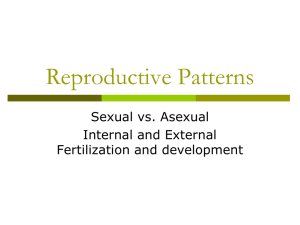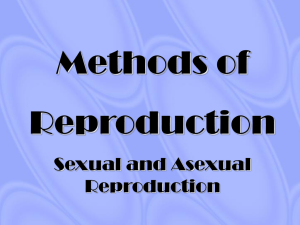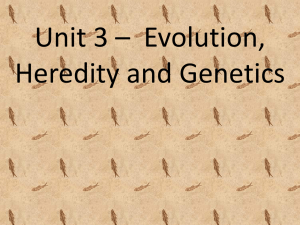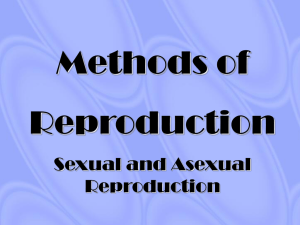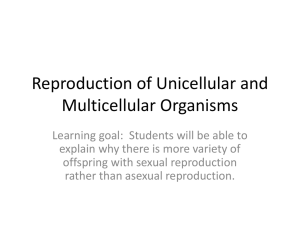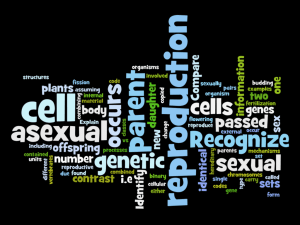Methods of Reproduction
advertisement
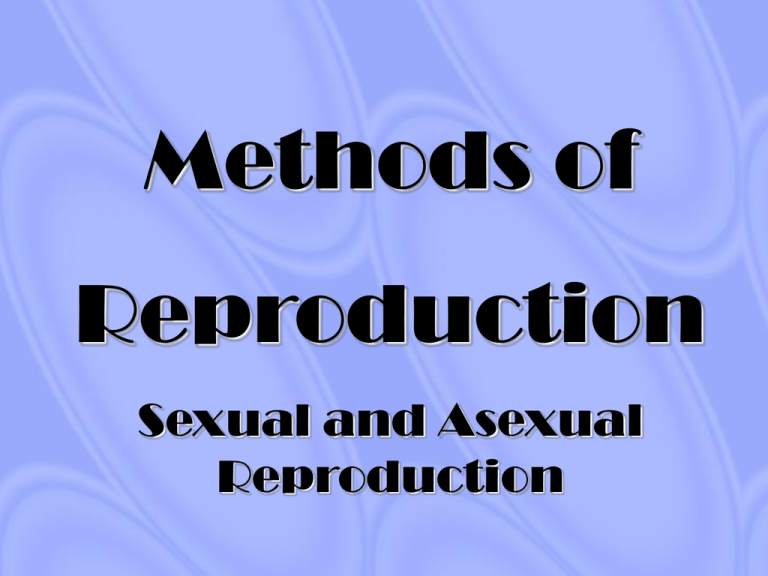
Methods of Reproduction Sexual and Asexual Reproduction Asexual Reproduction: requires only 1 parent and the offspring are an exact copy of the parent---a clone Asexual Reproduction: • Organisms that reproduce asexually cannot develop much variety, because they are “copying” the original organism exactly. Methods of asexual reproduction: Binary fission Budding Fragmentation Parthenogenesis Binary fission Single-celled organisms (Amoeba, paramecium, euglena) which use asexual reproduction can do so simply by dividing into two equal halves. This is called binary fission. • When conditions are good, such as plenty of water, food, right temperatures, etc., binary fission is a very effective way of producing many, many offspring. • For example, the cell of a Paramecium can divide, grow, and divide again in the space of 8 hours. Budding- an offspring grows out of the body of the parent. offspring Hydra Budding Cactus Budding Budding In yeasts the cell does not divide equally in two halves; instead, there is a large mother cell and a smaller daughter cell. Yeast - budding Fragmentation In this form, the body of the parent breaks into distinct pieces, each of which can produce an offspring. Pieces of coral broken off in storms can grow into new colonies. A new starfish can grow from one detached arm. Fragmentation- plant cuttings Some plants can grow from cutting them up and replanting them. Green plants are quite sophisticated in their methods of asexual reproduction. Offspring may be produced by runners, bulbs, rhizomes or tubers. Parthenogenesis Parthenogenesis is a form of asexual reproduction in which females produce eggs that develop without fertilization. Parthenogenesis is seen to occur naturally in some invertebrates, along with several fish, amphibians, and reptiles as well as in many plants. There are no known cases of parthenogenesis in mammals. Can I have some spore? • Spore Formation – spores = small specialized cells that contain a nucleus and cytoplasm surrounded by a thick outside wall which protects the spore. Under the right conditions the spore can rise to a new organism. Found in bacteria, molds, yeast, mushrooms, mosses, ferns and some protozoans. Spore formation Vegetative Reproduction • Bulb = Short underground stem surrounded by thick leaves. Contain stored food. As the plant grows it produces new bulbs which will grow into new plants. Tulips, onions, and lilies. • Corms = Similar to bulbs but do not contain leaves, just undergroun d stems. Water chestnuts. • Grafting = Bud or stem of one plant is permanently attached to the stem or trunk of a very similar plant. The cambium layers grow together and form a single plant. Apple trees. What is sexual reproduction? • Requiring 2 parents – male and female (egg & sperm) • The egg and sperm join (zygote) to form an entirely new organism • Offspring are different from the parent organism because Sexual Reproduction: Requiring 2 parents (egg & sperm) Combining different genetic material Methods of sexual reproduction: Pollination External Fertilization Internal Fertilization Pollen is produced in the male organs of the flowers - anthers. Pollination occurs when pollen is transferred from the anthers to the female organs by wind or by animals. If the female stigma is receptive to a pollen grain, the pollen produces a pollen tube, which grows through the female tissue to the egg, where fertilization takes place by the sperm nucleus. Sexual Reproduction in Flowering Plants External Fertilization • External fertilization usually requires a medium such as water, which the sperms can use to swim towards the egg cell. External fertilization usually occur in fish and amphibians. • The females lay the eggs in the water and the male squirts the sperm in the same area. Internal Fertilization • Fertilization occurs within the female. • Internal fertilization occurs in mammals, insects, birds, reptiles. – Mammals (gorillas, lions, elephants, rats, zebras, and dolphins have live births) – Insects, birds, reptiles lay eggs Sexual Reproduction • Sexual reproduction produces a greater chance of variation within a species than asexual reproduction would. • This variation improves the chances that a species will adapt to his environment and survive. Sexual vs. Asexual Reproduction • Asexual reproduction results in offspring that are genetically identical to the parent organism. • Sexual reproduction results in offspring that are genetically different from the parent organisms.


